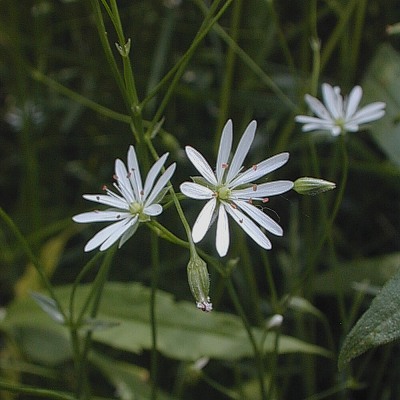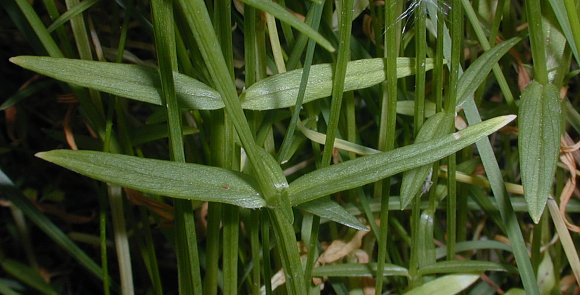Description: This herbaceous perennial plant is about ¾–1½' tall and largely unbranched, except at the apex where the inflorescence occurs. The central stem is glabrous, 4-angled, and rather weak, causing the plant to lean over in the absence of supportive vegetation. The opposite leaves are up to 1½" long and 1/3" (8 mm.) across. They are lanceolate-linear or linear, smooth along the margins, sessile, and glabrous, except for a few hairs near the base of the lower leaves.

The central stem terminates in a dichotomously branching panicle of cymes. A pair of small green bracts occurs where the panicle branches. Each cyme is rather floppy and consists of 1-3 flowers on slender pedicels. Each flower is about 1/3" (8 mm.) across, consisting of a corolla with 5 deeply divided white petals (which can appear to be 10 petals), 10 stamens with brown or reddish brown anthers, a green pistil with 3 styles, and 5 green sepals that are lanceolate. Each sepal has 3 conspicuous veins along its outer surface, which is also somewhat ciliate or pubescent. The petals of the flower are longer than the sepals. The blooming period occurs from late spring to early summer and lasts about a month. An abundance of flowers is normally produced. Each flower is replaced by a straw-colored or light brown seed capsule that contains numerous small seeds. This capsule is ovoid-oblongoid in shape and open at the top, where a few erect teeth occur along the upper rim. Each seed is oval-orbicular and somewhat flattened; its surface is rough and pebbly. The root system consists of a shallow taproot and rhizomes. This plant spreads vegetatively or by reseeding itself, and often forms small colonies.

Cultivation:
Typical
growing conditions are full sun and moist to mesic soil. This plant
grows quite well in loam or clay-loam.
Range & Habitat:
The non-native Grass-Leaved Chickweed occurs occasionally in scattered
counties
throughout Illinois (see Distribution
Map). It is adventive from Europe. Habitats include old
fields, grassy meadows, and roadsides. This plant competes well against
Kentucky Bluegrass and similar grass species, but broad-leafed forbs
have a tendency to cast too much shade for it to flourish. Grass-Leaved
Chickweed is found primarily in disturbed areas.
Faunal Associations:
The nectar and pollen of the flowers attract small bees and flies
primarily. The caterpillars of several moth species feed on the foliage
of Chickweeds, including Agrostis venerabilis
(Venerable Dart), Lobocleta ossularia (Drab Brown
Wave), and Haematopis grataria (Chickweed
Geometer). Mourning Doves and various sparrows occasionally eat the
seeds of Chickweeds, while rabbits and groundhogs eat the foliage.

Photographic
Location:
A grassy meadow at Judge Webber Park in Urbana, Illinois.
Comments:
This is one of the more attractive chickweeds, particularly when it
occurs in colonies, because the attractive flowers are produced in
great abundance and the foliage is elegant and grass-like. It has a
similar appearance to the native Stellaria longifolia
(Long-Leaved Stitchwort). However, this latter species has sepals that
are without conspicuous veins or hair, and its seeds have a smooth
surface. Long-Leaved Stitchwort produces flowers less abundantly than
Grass-Leaved Chickweed, and some of its flowers develop from the axils
of the leaves. There are many other Stellaria spp.
(chickweeds), as well as Cerastium spp.
(mouse-eared chickweeds), but they often have broader leaves and
hairier foliage. Another common name for Stellaria graminea
is Common Stitchwort.